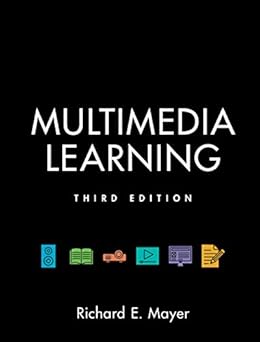Key Highlights
- •Based on the influential Cognitive Theory of Multimedia Learning.
- •Features evidence-based principles for effective instructional design.
- •Updated 3rd Edition includes the latest research and refinements.
Description
Struggling to make your lessons, presentations, or training materials really stick? Ever wonder how people actually learn best when you combine words and pictures? Then you need (PDF)Multimedia Learning 3rd Edition by Richard E. Mayer! This isnt just another education theory book; it's your practical, science-backed guide to creating powerful multimedia instruction that genuinely helps people learn. Keywords: multimedia learning principles, instructional design guide, cognitive theory of learning, educational psychology book, e-learning development, effective teaching strategies.
Who is this book for? It’s a must-have resource for educators at all levels (K-12, higher ed), instructional designers crafting online courses or job aids, e-learning developers building interactive modules, corporate trainers wanting more engaging sessions, and even researchers and students digging into educational psychology or technology. If you create learning materials using text, audio, images, animation, or video, this book is definately for you.
What problem does this book solve? Are you tired of creating presentations that fall flat? Worried your online content isn't leading to real understanding? This book tackle the core problem: how to design multimedia messages that align with how the human mind processes information. It moves beyond intuition and fads, giving you concrete strategies based on cognitive science to avoid overloading learners and instead promote deep, meaningful learning. Stop guessing what works and start designing based on evidence.
What will you gain from reading it? You'll master Mayer's renowned principles of multimedia learning (like coherence, signaling, redundancy, spatial contiguity, temporal contiguity, segmenting, pre-training, modality, multimedia, personalization, voice, and image principles). You'll understand the 'why' behind these principles, grounded in the Cognitive Theory of Multimedia Learning. This book help you critically evaluate existing multimedia and confidently create new materials—presentations, videos, online modules—that enhance learner engagement, reduce cognitive load, and ultimately improve learning outcomes and retention. It’s practical knowlege you can apply right away.
Why is it worth reading? Richard E. Mayer is a giant in the field of educational psychology, and this book represents decades of rigorous research translated into actionable advice. This updated 3rd Edition includes the latest research findings, new examples, and refined explanations, keeping it incredibly relevant. It explain complex cognitive concepts clearly, without being overly academic, making it accessible and hugely valuable. Its considered the foundational text for anyone serious about effective multimedia instruction.
Ready to level up your teaching and design skills? Download the (PDF)Multimedia Learning 3rd Edition now and unlock the secrets to creating learning experiences that truly resonate!
FAQ
Is this book too academic or theoretical for a classroom teacher?
While it's based on cognitive science, Mayer explain the concepts clearly. It focuses on practical principles that teachers can apply directly to presentations, worksheets, and online resources. Many teachers find it very useful!
Does the book tell me which specific software (like PowerPoint or Articulate Storyline) to use?
No, the book focuses on the *principles* of effective design, not specific tools. The ideas can be applied using almost any software you use to create multimedia materials.
I have the 2nd edition. What's new in the 3rd Edition?
The 3rd Edition includes updates based on recent research, refined explanations of the principles, new examples, and potentially new chapters or sections reflecting advancements in the field since the previous edition. It keeps the core knowledge fresh and up-to-date.
Are the principles applicable to adult learners in corporate training?
Absolutely! The cognitive principles of how people learn from multimedia apply across different age groups and contexts, including workplace training and professional development. Many corporate trainers use these principles.
Does the book cover things like game-based learning or virtual reality?
The core principles discussed are foundational and can certainly inform the design of more advanced technologies like educational games or VR, but the main focus is on the fundamental ways people learn from combinations of words and pictures/audio in more typical multimedia formats (like slides, videos, diagrams).
Is the PDF format searchable?
Typically, PDF versions of textbooks like this are searchable, which makes it really easy to find specific principles or topics you need quick.
Reader Reviews
About the Author
Richard E. Mayer is a distinguished Professor of Psychology at the University of California, Santa Barbara. He is a world-renowned expert in educational psychology and multimedia learning, with extensive research focused on how people learn and how to apply cognitive science to improve instruction. His work has significantly influenced the fields of education and instructional design globally. He has authored numerous books and research articles on the topic.
